New Science
-
Spaceflight Now: Spitzer Captures Fruits of Massive Stars’ Labours
2005-06-19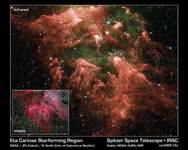 The striking picture reveals an eclectic mix of embryonic stars living in the tattered neighbourhood of one of the most famous massive stars in our Milky Way galaxy, Eta Carinae. Astronomers say that radiation and winds from Eta Carinae and its massive siblings ripped apart the surrounding cloud of gas and dust, shocking the new stars into being.
The striking picture reveals an eclectic mix of embryonic stars living in the tattered neighbourhood of one of the most famous massive stars in our Milky Way galaxy, Eta Carinae. Astronomers say that radiation and winds from Eta Carinae and its massive siblings ripped apart the surrounding cloud of gas and dust, shocking the new stars into being. -
A Bubble Bursts
2005-04-28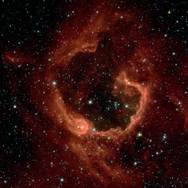 The balloon of gas and dust is an example of stimulated star formation. Such stars are born when the hot bubble expands into the interstellar gas and dust around it. RCW 79 has spawned at least two groups of new stars along the edge of the large bubble. Some are visible inside the small bubble in the lower left corner. Another group of baby stars appears near the opening at the top.
The balloon of gas and dust is an example of stimulated star formation. Such stars are born when the hot bubble expands into the interstellar gas and dust around it. RCW 79 has spawned at least two groups of new stars along the edge of the large bubble. Some are visible inside the small bubble in the lower left corner. Another group of baby stars appears near the opening at the top. -
Spitzer Space Telescope: NASA’s Spitzer Telescope Sees Signs of Alien Asteroid Belt
2005-04-27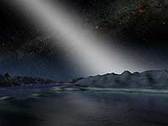 (Spitzer Space Telescope) NASA’s Spitzer Space Telescope has spotted what may be the dusty spray of asteroids banging together in a belt that orbits a star like our Sun. The discovery offers astronomers a rare glimpse at a distant star system that resembles our home, and may represent a significant step toward learning if and where other Earths form.
(Spitzer Space Telescope) NASA’s Spitzer Space Telescope has spotted what may be the dusty spray of asteroids banging together in a belt that orbits a star like our Sun. The discovery offers astronomers a rare glimpse at a distant star system that resembles our home, and may represent a significant step toward learning if and where other Earths form. -
Five Out of Five Researchers Agree: Earth's Solar System Special
2005-04-20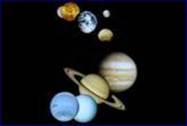 Neil DeGrasse Tyson, the Frederick P. Rose Director of the Hayden Planetarium, moderated the informal discussion. At issue was whether our solar system is special, why it looks the way it does, and how others thus far detected differ. The debate took place between theoretical and observational scientists on the different aspects of detecting and categorising alien solar systems. About 700 people attended the event.
Neil DeGrasse Tyson, the Frederick P. Rose Director of the Hayden Planetarium, moderated the informal discussion. At issue was whether our solar system is special, why it looks the way it does, and how others thus far detected differ. The debate took place between theoretical and observational scientists on the different aspects of detecting and categorising alien solar systems. About 700 people attended the event. -
X-Ray Vision of Violence in Interacting Galaxies
2005-04-19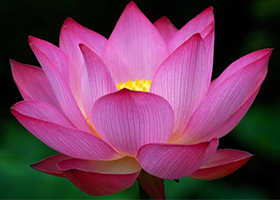 Using the world's most powerful X-ray space observatory, the team is unravelling the complex interactions that take place in the "traffic pile-ups" that occur as clusters containing hundreds of galaxies and trillions of solar masses of gas and dark matter interact and merge.
Using the world's most powerful X-ray space observatory, the team is unravelling the complex interactions that take place in the "traffic pile-ups" that occur as clusters containing hundreds of galaxies and trillions of solar masses of gas and dark matter interact and merge. -
Reborn Star Surprises Astronomers
2005-04-15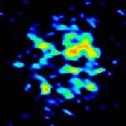 According to a report from Space.com on April 7, 2005, the rebirth of an old star named V4334 SGR in the constellation Sagittarius, which was observed by using National Science Foundation's Very Large Array (VLA) radio telescope, has surprised researchers by flying through the process 100 times faster than predicted. The surprising rebirth forced researchers to produce new models of how such an old, white dwarf star could re-ignite its nuclear furnace for one final blast of energy.
According to a report from Space.com on April 7, 2005, the rebirth of an old star named V4334 SGR in the constellation Sagittarius, which was observed by using National Science Foundation's Very Large Array (VLA) radio telescope, has surprised researchers by flying through the process 100 times faster than predicted. The surprising rebirth forced researchers to produce new models of how such an old, white dwarf star could re-ignite its nuclear furnace for one final blast of energy. -
Missing Link between Galaxy Collisions and Star Birth Is Found
2005-04-13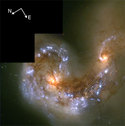 Data from ISO, the infrared observatory of the European Space Agency (ESA), have provided the first direct evidence that shock waves generated by galaxy collisions excite the gas from which new stars will form. The result also provides important clues on how the birth of the first stars was triggered and sped up in the early Universe.
Data from ISO, the infrared observatory of the European Space Agency (ESA), have provided the first direct evidence that shock waves generated by galaxy collisions excite the gas from which new stars will form. The result also provides important clues on how the birth of the first stars was triggered and sped up in the early Universe. -
X-rays Signal Presence of Elusive Black Hole
2005-04-06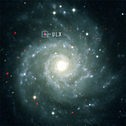 According to a Chandra X-Ray Centre News Release on March 23rd, 2005, peculiar outbursts of X-rays coming from a black hole in the galaxy Messier 74 (M74) have provided evidence that the black hole has a mass of about 10,000 Suns, which would place it in a possible new class of black holes. These outbursts were observed with NASA's Chandra X-ray Observatory.
According to a Chandra X-Ray Centre News Release on March 23rd, 2005, peculiar outbursts of X-rays coming from a black hole in the galaxy Messier 74 (M74) have provided evidence that the black hole has a mass of about 10,000 Suns, which would place it in a possible new class of black holes. These outbursts were observed with NASA's Chandra X-ray Observatory. -
Universe Today: Super Star Cluster Discovered in Our Own Milky Way [Excerpt]
2005-03-30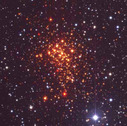 The Milky Way has several star clusters; collections of stars pulling each other into a tight group. But now astronomers have located a super star cluster, containing hundreds of thousands of stars in a region only 6 light-years across. It's called Westerlund 1, and nobody discovered it before now because it's hidden behind thick clouds of dust.
The Milky Way has several star clusters; collections of stars pulling each other into a tight group. But now astronomers have located a super star cluster, containing hundreds of thousands of stars in a region only 6 light-years across. It's called Westerlund 1, and nobody discovered it before now because it's hidden behind thick clouds of dust. -
From the Discovery of Organisms in the Deepest Part of the Ocean to the Diversity of Life on Earth
2005-03-27 In the past few years, more and more of these types of findings have been recognised and reported. According to modern textbooks, these life forms are not possible because organisms cannot survive in such a hot, cold, profound depth on earth, or in highly salt-concentrated water and highly toxic places. Yet similar findings keep coming to the spotlight.
In the past few years, more and more of these types of findings have been recognised and reported. According to modern textbooks, these life forms are not possible because organisms cannot survive in such a hot, cold, profound depth on earth, or in highly salt-concentrated water and highly toxic places. Yet similar findings keep coming to the spotlight. -
Scientists Say Hassled Galaxy 'Thriving on Chaos'
2005-03-23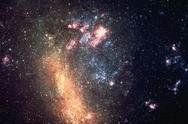 Powerful but unknown forces are at work in a small companion galaxy of the Milky Way, astronomers say in the latest issue of the journal Science. Something is keeping the structure and magnetic field of this galaxy (the Large Magellanic Cloud) strong and ordered, even while the Milky Way's gravity works to tear them apart.
Powerful but unknown forces are at work in a small companion galaxy of the Milky Way, astronomers say in the latest issue of the journal Science. Something is keeping the structure and magnetic field of this galaxy (the Large Magellanic Cloud) strong and ordered, even while the Milky Way's gravity works to tear them apart. -
NASA Publishes Image of Two-Billion-Year-Old Gabon Nuclear Reactor
2005-03-08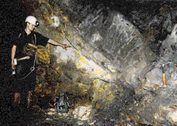 The remnants of nuclear reactors nearly two billion years old were found in the 1970s in Africa. Pictured above is Fossil Reactor 15, located in Oklo, Gabon. Uranium oxide remains are visible as the yellowish rock. Oklo by-products are being used today to probe the stability of the fundamental constants over cosmological time-scales and to develop more effective means for disposing of human-manufactured nuclear waste.
The remnants of nuclear reactors nearly two billion years old were found in the 1970s in Africa. Pictured above is Fossil Reactor 15, located in Oklo, Gabon. Uranium oxide remains are visible as the yellowish rock. Oklo by-products are being used today to probe the stability of the fundamental constants over cosmological time-scales and to develop more effective means for disposing of human-manufactured nuclear waste. -
Ancient Chinese Folk Remedy May Hold Key to Non-Toxic Cancer Treatment
2005-02-27 The next step, according to Lai, is animal testing. Limited tests have been done in that area. In an earlier study, a dog with bone cancer so severe it couldn’t walk made a complete recovery in five days after receiving the treatment. But more rigorous testing is needed.
The next step, according to Lai, is animal testing. Limited tests have been done in that area. In an earlier study, a dog with bone cancer so severe it couldn’t walk made a complete recovery in five days after receiving the treatment. But more rigorous testing is needed. -
Planets Galore: Twelve New Discoveries Announced
2005-02-21 Just a decade ago, scientists knew of only the nine planets - those in our local solar system. In 1995, improved detection techniques produced the first solid evidence of a planet circling another star. A proliferation of discoveries followed, and now dozens of ongoing search efforts around the globe add steadily to the roster of worlds. Most of these planets differ markedly from the planets in our own solar system. They are more similar to Jupiter or Saturn than to Earth, and are considered unlikely to support life as we know it.
Just a decade ago, scientists knew of only the nine planets - those in our local solar system. In 1995, improved detection techniques produced the first solid evidence of a planet circling another star. A proliferation of discoveries followed, and now dozens of ongoing search efforts around the globe add steadily to the roster of worlds. Most of these planets differ markedly from the planets in our own solar system. They are more similar to Jupiter or Saturn than to Earth, and are considered unlikely to support life as we know it. -
Strange Comet of Solar System Defies Gravity
2005-02-20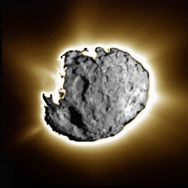 Brownlee told SPACE.com that Wild 2Â could represent a unique class of comet. He and his colleagues had expected it to be relatively featureless with a dusty, charcoal-like coating. Instead they found a place riddled with apparently ancient impact craters. Broad mesas and steep canyons stand out clearly.
Brownlee told SPACE.com that Wild 2Â could represent a unique class of comet. He and his colleagues had expected it to be relatively featureless with a dusty, charcoal-like coating. Instead they found a place riddled with apparently ancient impact craters. Broad mesas and steep canyons stand out clearly.



 more ...
more ...